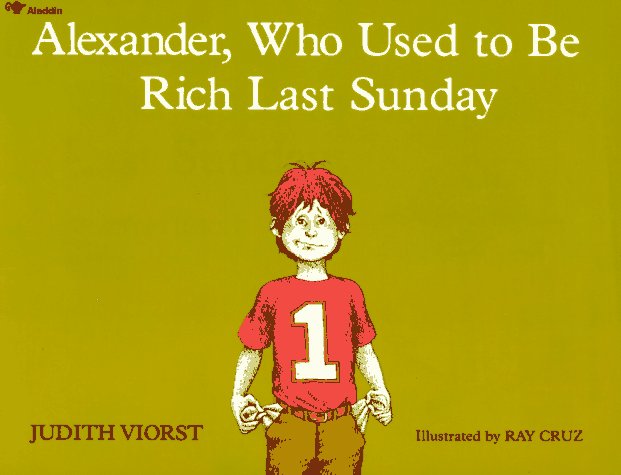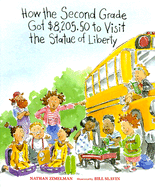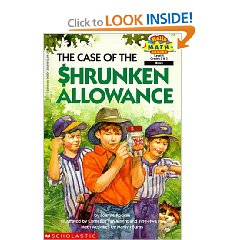Introduction
Money Rhymes
Twenty five cents,
Money that rhymes,
Take one nickel
Add two dimes.
Three fat nickels,
One thin dime.
Makes twenty-five cents
Every time.
Five fat nickels,
No thin dimes.
Makes twenty-five cents
Any time.
In 3rd grade, a part of measurement involves money concepts. Students are expected to build off their prior money knowledge and continue expanding their skills by counting, identifying coins, adding/subtracting, and comparing values.
Books
 Alexander, Who Used to Be Rich Last Sunday, written by Judith Viorst and illustrated by Ray Cruz – This is a story about a naive young boy who discovers the true value of a dollar. The book begins with Alexander receiving money from his Grandmother Betty and Grandfather Louie. He promises to save the money until he realizes all the exciting things he can purchase with a dollar. The book teaches coin values and subtraction.
Alexander, Who Used to Be Rich Last Sunday, written by Judith Viorst and illustrated by Ray Cruz – This is a story about a naive young boy who discovers the true value of a dollar. The book begins with Alexander receiving money from his Grandmother Betty and Grandfather Louie. He promises to save the money until he realizes all the exciting things he can purchase with a dollar. The book teaches coin values and subtraction.
 How the Second Grade Got $8,205.50 to Visit the Statue of Liberty, written by Nathan Zimelman and illustrated by Bill Slavin. This is a whimsical tale of a second grade classroom struggling to raise money for a class field trip to the statue of liberty. The students attempt multiple fund-raising adventures in order to earn money for their trip. The book takes the reader through all the triumphs and setbacks that the students experience. The main focus of the book is savings and the value of money.
How the Second Grade Got $8,205.50 to Visit the Statue of Liberty, written by Nathan Zimelman and illustrated by Bill Slavin. This is a whimsical tale of a second grade classroom struggling to raise money for a class field trip to the statue of liberty. The students attempt multiple fund-raising adventures in order to earn money for their trip. The book takes the reader through all the triumphs and setbacks that the students experience. The main focus of the book is savings and the value of money.
 The Case of the Shrunken Allowance, written by Joanne Rocklin and illustrated by Cornelius Wright. The story is a humorous tale about Mike and his friends. Mike discovers that the money in his money jar is shrinking and he uses clues, like the different sizes of the money remaining in the jar, to determine how much money is missing. The reader helps solves the mystery behind the disappearance of Mike’s allowance. The book revolves around adding, subtracting, and coin identification.
The Case of the Shrunken Allowance, written by Joanne Rocklin and illustrated by Cornelius Wright. The story is a humorous tale about Mike and his friends. Mike discovers that the money in his money jar is shrinking and he uses clues, like the different sizes of the money remaining in the jar, to determine how much money is missing. The reader helps solves the mystery behind the disappearance of Mike’s allowance. The book revolves around adding, subtracting, and coin identification.
 Careless at the Carnival, written by Dave Ramsey and illustrated by Marshall Ramsey. Is a story about a young boy named Junior who decides to go to a local carnival with a bunch of his friends. Junior’s mom tells him not to spend all his money. Instead of listening to his mother, Junior ends up being careless at the carnival and loosing all his money. The book focuses on subtracting and the importance of saving money.
Careless at the Carnival, written by Dave Ramsey and illustrated by Marshall Ramsey. Is a story about a young boy named Junior who decides to go to a local carnival with a bunch of his friends. Junior’s mom tells him not to spend all his money. Instead of listening to his mother, Junior ends up being careless at the carnival and loosing all his money. The book focuses on subtracting and the importance of saving money.
 Sluggers’ Car Wash, written by Stuart Murphy and illustrated by Barney Saltzberg. Is a story about a baseball team who wants to invest in new uniforms for their playoff game. The only way they can purchase the uniforms is to have a fundraiser. The team decides a car wash is the best way to raise the money. The team learns to keep track of their dollars and cents and practices giving back change. The reader learns the concept of saving, adding money, and equivalency.
Sluggers’ Car Wash, written by Stuart Murphy and illustrated by Barney Saltzberg. Is a story about a baseball team who wants to invest in new uniforms for their playoff game. The only way they can purchase the uniforms is to have a fundraiser. The team decides a car wash is the best way to raise the money. The team learns to keep track of their dollars and cents and practices giving back change. The reader learns the concept of saving, adding money, and equivalency.
Kid Friendly Websites
* Cash Out The site begins by giving the choice of easy, medium, or hard depending on the child’s ability. You can also select to use the help tab during the game. The help tab provides the child with the correct change amount and the child will only need to determine which coins are needed to met the correct change. During the game the child is given an item, like a carrot, and a price of .76 cents. Then the child is given an amount of money for the item, like a 1.00. It is the child’s job to figure out the change for the item by clicking on the coins by the cash register. If the child answers incorrectly, the game will inform him/her how much more money is needed to meet the ideal goal amount.
* Money Flashcards This site focuses on the combination of coins and dollars. Kids are given different flashcards with dollar and coin. Kids must count the amounts shown and type in the correct answer. Although, this site does not give the child a second chance to correct his/her wrong answers, it does provide the child with number sentences with the correct answers.
* Counting Money Game This game focuses on coin amounts. Kids must count the different coins and then type in the correct amount. If they type in the correct amount the game will say “correct” and move onto the next question. If the child answers incorrectly the game will tell the child first if the answer is greater than or less than the amount they guessed. The child is given another chance to answer the question, if he/she gets it wrong again, the game then gives the child some additional assistance with counting the money.
* Dollar Dive The goal of the game is to get the required amount of coins so you can buy sails for your boat. The mission is to escape the sea monster and get home as fast as possible. Kids practice counting and identifying coins. There are three levels to the game and each level is designed to challenges the child.
* Piggy Bank Game This game gives kids the opportunity to find the correct change needed for the piggy bank. Each game begins with an amount for the piggy bank and kids needs to select the coins that will equal that amount. Every time the child gets the right answer, a part of the piggy banks becomes highlighted. The child wins once the whole pig becomes highlighted in a green color.
Additional Teacher Resources
* Additional Book Resources This is a thesis paper by Davina Hunt, a student from Virginia Tech. Her thesis paper connects kids with books based on money. The paper is filled with more than fifty-five kid friendly books on money concepts. She gives a synopsis on each book, which provides a good reference for additional classroom resources. At the end of the thesis, she also has lesson plans for Alexander who use to be Rich Last Sunday and Berenstain Bears Trouble with Money.
* Literature Guides This sites provides a lesson plan for Alexander who use to be Rich Last Sunday. The website is full of activities to do before, during, and after reading the book with your students. An example of an activity that appears of the site is: to read the parts of the story where Alexander spends (or loses) money and make a list where the money went. Use fake money to count out his losses from one dollar to nothing.
* Playing with Coins This site is by Geddes and it provides free lesson plans for money. The lesson plans can be used with the book The Shrunken Allowance and it incorporates fun activities students can try while reading the book. The activities are excellent for individual assignments or group projects.
* Keeping Track of our Money This is an excellent resource for large group activities. This site is ideal to use with the book How the Second Grade got $8,205.50 to Visit the Statue of liberty. The site provides worksheets for students in managing money and tools for recording money. It helps students organize money into columns and it teaches them about saving.
